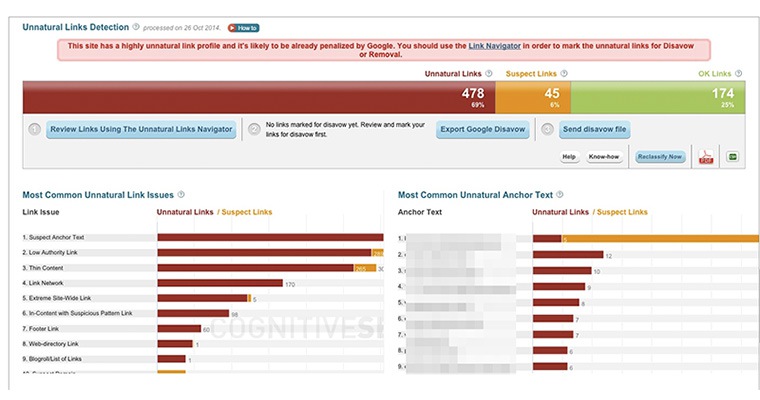One thing you never want to see in the Google Webmaster Tools is an unnatural link warning message. Should you stumble upon one of these messages, this article will cover what to expect and how to handle the different warning types.
The warnings appear only in Google Webmaster Tools as the result of a manual action taken against your website. They are messages personally sent by Google employees from the Webspam department who were tasked with analyzing your site for suspicious links.
Whether your site was the target of a negative SEO campaign, or Google simply believes you’ve used some shady tactics to rank up, they compile a list of unnatural links on your site and send you a message. Before we dive into the message types, lets first look at the differences between manual and automatic penalties.
Manual Action Warnings vs. Automatic Google Algorithm Penalties
There is a lot of confusion regarding unnatural link warnings. There are two types of penalties Google uses: manual and algorithmic. This misunderstanding began with the first Penguin update was made and it’s still something lots of webmasters and website owners have trouble determining. To shed some light over this unsettling matter I am going to go over some differences between manual actions and Penguin penalties:
Manual actions, as the name suggests, refer to actions manually taken by Google employees who personally review your website and your link profile. If Google thinks you may have deployed some devious techniques in order to rank better in their search results, then you might receive a warning. Manual link warnings have nothing to do with penalties caused by Google’s algorithm updates like Penguin or Panda. These types of warnings are deployed only when you’re in violation of Google’s guidelines.
[pullquote]You will receive unnatural link warnings in the “Manual Actions” section of Google Webmaster Tools.[/pullquote]
On the other side, penalties resulted from Penguin and Panda updates (called algorithmic penalties) are made when Google releases these algorithmic updates and automatically evaluates not only your links but your entire site. Google is putting a lot of effort in improving the algorithm in order to minimize the involvement of human reviewers. These penalties are automated, based on their algorithm, and evaluated on the spot.
The biggest difference between these two penalties is that if your site is affected by the Penguin or Panda update, you won’t receive any written warning from Google. You will just experience a sudden drop in rankings.
Now that you understand the differences between manual and algorithmic penalties, let’s take a look at the types of manual warnings you might see.
Warning 1: Unnatural Links From Your Site
The first type of unnatural link warning is received by the webmaster when Google finds your link profile contains unnatural outbound links. This is what that warning will look like:
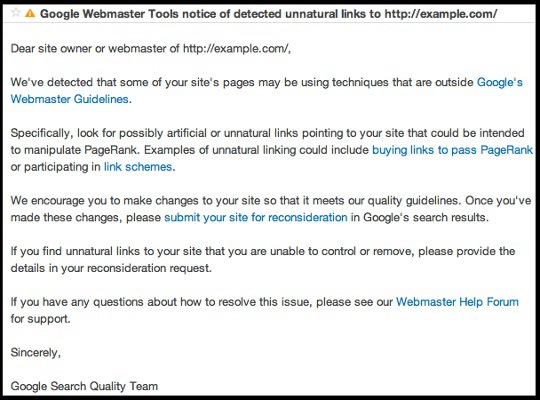 Screenshot taken 02/08/2015 of https://www.google.com/webmasters/tools/
Screenshot taken 02/08/2015 of https://www.google.com/webmasters/tools/This means you are ranking using techniques that are against Google’s guidelines. The warning “Unnatural links from your site” is associated with a manual action that affects only the concerning part of your site. This type of actions are classified as “Partial matches”. The other type of actions are called “Site-wide matches”, which affect the whole site.
After you’ve acknowledged the violation, you need to attend to the problem and solve it. To do so, you need to identify which links are unnatural (Google won’t specify which links are violating their guidelines). Then, you should work to remove them or apply a rel=”nofollow” tag. Another way to fix the situation would be to use a 301 Redirect attribute through a page that’s blocked by robots.txt. After you’ve identified and dealt with all the unnatural links, you should create a reconsideration request for your site. This request lets Google know that you’re on the correct path and you want the manual action to be revoked.
Warning 2: Unnatural Links to Your Site
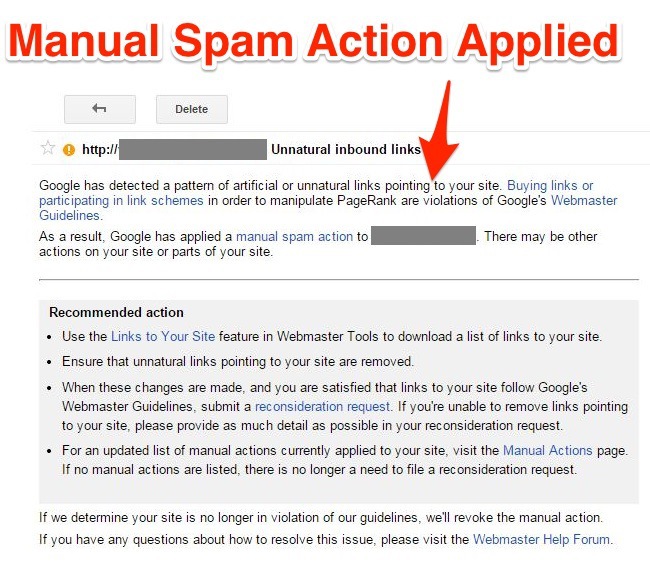 Screenshot taken 02/08/2015 of https://www.google.com/webmasters/tools/
Screenshot taken 02/08/2015 of https://www.google.com/webmasters/tools/The second type of warning comes when you get a message in Google Webmasters Tools announcing that Google exposed some unnatural links pointing to your site. Moreover, with this kind of warnings, Google provides a few links as an example of bad links pointing to your website. The main difference between this message and the warning above is that in this case Google detected a pattern of unnatural links that are pointing to your site.
This is also a violation of Google’s guidelines and will be penalized. Because this may not be a devious scheme on your part in order to influence the search results, there will only be a penalty on the areas of the site which have many unnatural links pointing to them. As in the case of unnatural links from your site, this is also classified as “Partial matches”.
In order to get rid of your penalty, you need to get rid of the unnatural links. It’s a little bit more difficult than in the case of links from your site because you don’t know which domains have unnatural links pointing to your site. You need to undergo a couple of steps:
- Download a list of all your links to your site using Webmaster Tools
- Check every link to see whether it’s unnatural or not. To make your job easier you should start checking the domains that have the most links to you. You can ease this job by using third-party tools which specialize in identifying types of unnatural links, such as cognitiveSEO (disclaimer: this is my company). There are a lot of types of unnatural links and you need to identify them all in order to get rid of your penalty
- After you’ve identified the rotten links that are harming your ranking, you could contact the webmasters of those domains and request that they remove the link or add a rel=”nofollow” tag
- Google recommends only after you’ve done a serious work contacting webmasters to remove the links should you use the Disavow links tool. Google created this tool to help you get rid of the links you were unable to get removed. Only after you’ve made an effort to remove the unnatural links that were violating Google’s guidelines you might have the manual action removed.
- In some cases, Google will remove all the bad links, and your penalty will be lifted. But usually, it takes more than a couple of reconsideration attempts to make Google lift your penalty and begin the recovery process.
Google wants to see you make a real effort to contact webmasters for link removal before you use the disavow tool. It is likely that Google won’t accept your reconsideration request in the first try.
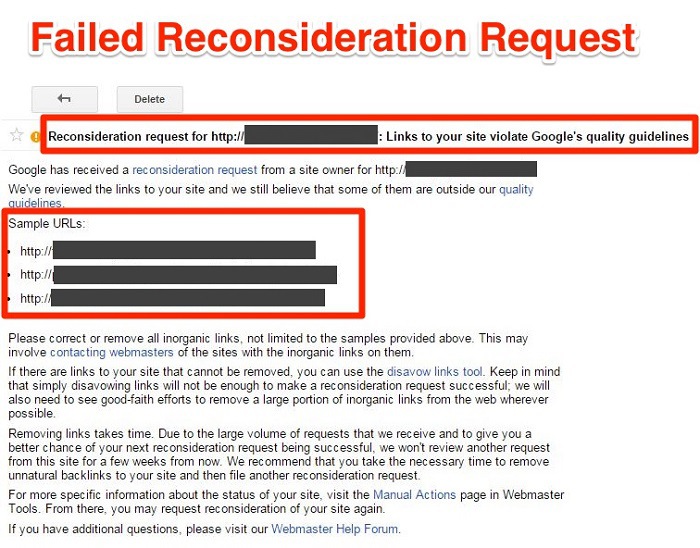 Screenshot taken 02/08/2015 of https://www.google.com/webmasters/tools/
Screenshot taken 02/08/2015 of https://www.google.com/webmasters/tools/Warning 3: Unnatural Links to Your Site (Impacts Links)
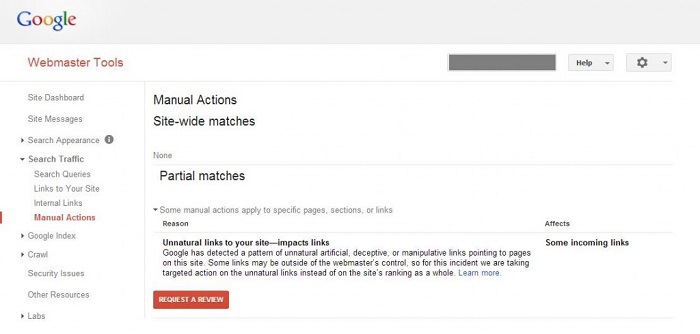 Screenshot taken 02/08/2015 of https://www.google.com/webmasters/tools/
Screenshot taken 02/08/2015 of https://www.google.com/webmasters/tools/There is a little bit more nuance when it comes to unnatural links that are pointing to your site. The difference between this warning and the one above is pretty much contextual. Google figured out that your site was involved in some unnatural link building schemes that point back to your site; if this is still unclear, Matt Cutts (head of webmaster team at Google, currently on leave) did explain the impact links here.
As he states, this may be a result of your own doings or may appear without any involvement on your part. Google takes that into account when they’re considering a manual action. They will only penalize the affected part of your site.
[pullquote]Be aware – Google will want proof of your efforts dealing with unnatural links and removing them.[/pullquote]
To clear the confusion out, even if you don’t have any control over these type of links, you should try to identify them and do your best to remove them. If you don’t control the links pointing to your site, no action is required on your part. From Google’s perspective, the links already won’t count in ranking.
If you want your penalty to be revoked you should include any proof of the process with your reconsideration request. You can show emails sent to webmasters that have unnatural links pointing to your site, requesting a link removal. Every step you to that shows your intentions of cleansing the site should go with the reconsideration request. It shows Google that you are committed and willing to do anything to go on the right path.
Conclusion
The most important lesson I want you to learn from this article is that all warning types can be fixed as long as you understand the differences between them and react accordingly. The first warning is completely under your control, and fixing it takes little effort, the next two warnings require a bit more work from your side.
Remember: Don’t just go to the disavow tool right away, as Google stated, it needs to see you are working on getting those links removed.
Google has a very restrictive policy regarding offering extra information to the user. This is one more reason why you should appreciate they send you unnatural link warnings through Webmaster Tools. And that is why you need to know how to read them and how to deal with them.
Featured Image Credit – Screenshot taken 02/08/2015 of http://tools.cognitiveseo.com/

